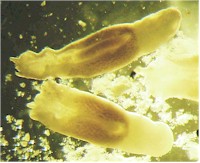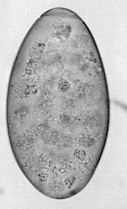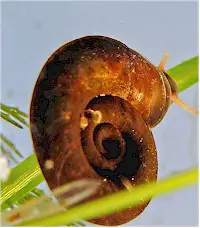Alaria is a genus of flatworm parasites that has dogs, cats and other carnivores (e.g. foxes, wolves, minks, etc.) as final hosts. It is found mainly in regions of Europe, Asia and America with temperate climate.
and other carnivores (e.g. foxes, wolves, minks, etc.) as final hosts. It is found mainly in regions of Europe, Asia and America with temperate climate.
It is not very common in dogs and cats, but prevalence in wild carnivores can reach up to 20% in endemic areas.
It is also infective for several vertebrates that act as transport hosts (= paratenic hosts) such as pig (and wild boars), poultry and other birds, which can feed on the intermediate hosts (tadpoles, frogs). The flukes do not complete development in such transport hosts, but remain infective for the final hosts if they feed on infected transport hosts. Humans can also act as transport hosts!
Alaria flukes are not infective for cattle, sheep, goats, horses and other herbivores.
The disease caused by Alaria flukes is called alariosis or alariasis.
The species of major veterinary importance are:
- Alaria alata. Occurs worldwide in temperate regions.
- Alaria marcianae. Found in North America
- Alaria canis = Alaria americana. Found in North America
Are animals infected with Alaria flukes contagious for humans?
- Pets. NO. If pets are infected with Alaria flukes, they are not contagious for humans, neither through contact, nor through the feces (it is assumed that they are not eaten by humans...).
- Pig and poultry and other wild hosts: YES if consumed uncooked. If pigs or poultry are infected with Alaria flukes, contact with the animals or their feces is not contagious for humans. But eating raw meat, fat or other tissues can be contagious. See the life cycle <below.
Human alariosis is extremely infrequent and difficult to diagnose, but can be serious. It can affect the lungs and the eyes.
You can find additional information in this site on the general biology of parasitic worms and/or flukes.
Final location of Alaria spp
Predilection site of adult Alaria flukes is the small intestine.
Anatomy of Alaria spp

Alaria flukes are rather small, usually <6 mm long and ~2 mm wide. The body has two differently shaped parts: the anterior half is flat, as most flukes, whereas the posterior half is conical to cylindrical. They have two small suckers, the oral larger than the ventral one. As other flukes, they have no external signs of segmentation.
The mouth ends in the pharynx, a muscular tube that allows sucking. The digestive system is blind (i.e. without exit: the only opening is the mouth) and not linear, as in most animals, but branched, ending in several blind ducts (called coeca). As most flukes, rumen flukes are simultaneous hermaphrodites, i.e. they have both male and female reproductive organs.
The eggs are oval and operculated. Those of Alaria alata are ~100x65 micrometers and grayish to greenish. Those of Alaria americana are larger (~130x70 micrometers) and yellowish to light brown.
Life cycle and biologyof Alaria spp
Alaria flukes have a complex indirect life cycle with two intermediate hosts, a snail and a frog. Freshwater snails (e.g. of the genera Planorbis and Heliosoma) are the first intermediate hosts.
Eggs produced by adult flukes in the final hosts are excreted with the host's feces. Once the eggs get in water they release miracidia larvae that can swim and actively find a suitable snail. Miracidia penetrate into the snail and develop to sporocysts and further to infective cercariae that leave the snail and can also swim. They find and penetrate tadpoles, where they continue development to mesocercariae, which takes about 2 weeks. Tadpoles or the resulting frogs are ingested either by a definitive host (dogs, cats, other carnivores) or by a transport host (e.g. snakes, birds, mice, pigs, etc.).
Dogs or cats become infected after eating infected frogs or transport hosts (mice, snakes, birds, etc.). The young flukes migrate through the diaphragm to the lungs where they produce metacercariae. These metacercariae reach the host's mouth and are swallowed to finally attain the small intestine, where they mature and start producing eggs, usually about 3 weeks after infection (= prepatent period).
Transport hosts (e.g. pigs, mice, birds, etc.) become also infected when eating contaminated tadpoles or frogs. The liberated mesocercariae migrate mostly to the muscles and the surrounding fat and connective tissue of the transport host, but also to other organs (e.g. the lungs, the eyes, etc.). They remain there in a dormant state, i.e. they do not complete development to adult flukes, but can wait for months until a definite host eats the transport host and they can resume development to adults.
Harm caused by Alaria infections, symptoms and diagnosis

Alaria infections of dogs and cats are mostly harmless and asymptomatic. In rare cases of massive infections metacercariae can cause enteritis and damage to the lungs.
For many transport hosts such as pigs and chicken infection is also harmless, not so for humans, that can be infected through consumption of contaminated meat of pig, wild boar and also chicken and other wild birds. In several Central European countries alariosis on wild boars is being increasingly diagnosed when inspecting the carcasses for trichinosis.
Diagnosis in dogs and cats is based on egg detection in fecal samples and the clinical history. Diagnosis on pigs, wild boars and other animals that can transmit the disease to humans requires meat inspection: so far no serological methods are available.
Prevention and control of Alaria infections
Best prevention for dogs and cats is to avoid that they eat potentially infected prays (frogs, mice, etc.). But this is often impossible to do for hunting dogs or in rural regions.
Alaria infections are not an issue in industrial pig and poultry operations, but can be a problem under traditional or free-ranging conditions in endemic regions.
To avoid transmission to humans, the basic preventative measure is to refrain from consuming raw meat of potentially infected hosts (mainly free-ranging pigs and birds, but also wild omnivores). Contaminated meat frozen at -20°C remains infective for up to 8 weeks. Pickling kills metacercariae in 2 to 3 weeks.
Chemical control of Alaria flukes is very unusual, and in most countries there are no pet or livestock anthelmintics with a claim against Alaria flukes. There are reports that praziquantel is effective against these flukes at the usual therapeutic dose against tapeworms.
Chemical control of the snails with molluscicides (i.e. snail killers) such as copper sulphate, sodium pentachlorophenate, niclosamide, etc. is never an option for controlling Alaria flukes in the environment. It would never be economic and is anyway hopeless and useless, because it is virtually impossible to treat every place where they can survive, and they reproduce extremely quickly. In addition, the use of such molluscicides is not approved in most countries.
There are so far no vaccines against Alaria flukes. To learn more about vaccines against parasites of livestock and pets click here.
Biological control of Alaria flukes (i.e. using their natural enemies) is so far not feasible.
You may be interested in an article in this site on medicinal plants against external and internal parasites.
|
Ask your veterinary doctor! If available, follow more specific national or regional recommendations for Alaria control. |
Resistance of Alaria spp to anthelmintics
So far there are no reports on resistance of Alaria flukes to anthelmintics.
This means that if an anthelmintic fails to achieve the expected efficacy, chance is very high that either the product was unsuited for the control of Alaria flukes, or it was used incorrectly.